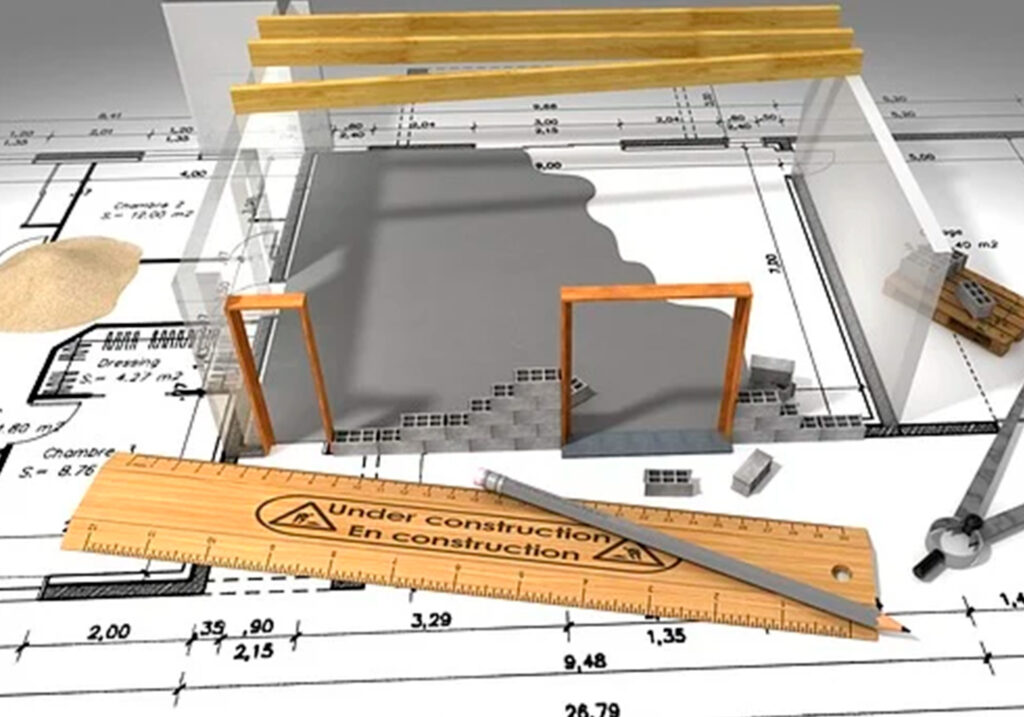One of the most important documents you need to bring to the permit office is your structural drawing. This puts in detail how you are going to build your new structure.
Structural drawings are a fundamental component of construction projects, serving as a blueprint for engineers, architects, and builders. They provide essential details about a building’s framework, ensuring stability, safety, and compliance with regulatory standards.
Without structural drawings, the construction process can become disorganized, leading to errors, delays, and even structural failures. That is why it is so important for you to bring them to the permit office.
This article explores the importance of structural drawings and their role in construction projects of all sizes.
First, why do you need a permit?
Building permits are essential because they ensure that construction projects comply with local building codes, zoning laws, and safety regulations. Permits are issued by government agencies to confirm that structures meet structural integrity, fire safety, and environmental standards. Without a permit, a construction project may violate legal requirements, leading to fines, forced modifications, or even demolition. These regulations exist to protect not only the property owner but also neighbors, future occupants, and the broader community.
In addition to safety and legal compliance, permits help maintain property value. A structure built without proper authorization may be flagged during property transactions, causing issues with selling or refinancing. Prospective buyers and lenders typically require proof that a building was constructed according to approved plans. If a property lacks permits for past modifications, the owner may be responsible for obtaining retroactive approval, which can be costly and time-consuming. Proper permitting helps avoid these complications and ensures that a property remains marketable.
Furthermore, securing a permit establishes accountability for contractors and builders. Since inspections are part of the permitting process, professionals must adhere to quality standards, reducing the risk of subpar work. This oversight protects property owners from faulty construction that could lead to structural failures or hazardous conditions.
The Purpose of Structural Drawings
Structural drawings serve as a visual representation of a building’s framework, detailing how different structural elements interact. These drawings provide guidance on materials, dimensions, and placement, ensuring that each component functions as intended. Structural drawings help minimize errors, reduce material waste, and improve overall efficiency in construction projects. Without them, builders would have to rely on guesswork, increasing the risk of errors and inconsistencies in construction.
Furthermore, structural drawings are essential for ensuring compliance with local building codes and regulations. Engineers use these drawings to verify that a structure can withstand environmental pressures such as wind, earthquakes, and heavy loads. Structural drawings also ensure that construction adheres to industry standards and safety requirements. Without them, contractors may struggle to interpret design specifications, leading to costly rework and safety risks that could delay project timelines and increase expenses.
In addition, structural drawings serve as a critical reference throughout a building’s lifecycle. From initial construction to future renovations or repairs, these detailed blueprints provide insight into the building’s design and integrity. Contractors, inspectors, and engineers can consult these drawings to assess structural conditions, determine load capacities, and ensure that modifications align with the original design. This long-term utility makes structural drawings invaluable for maintaining the safety and stability of buildings over time.
Components of Structural Drawings
Structural drawings consist of various elements that contribute to a comprehensive understanding of the building’s framework. Key components include foundation plans, floor plans, elevations, sections, and details of beams, columns, and reinforcements. Each component serves a specific purpose, providing clarity on load distribution and material specifications. Without these essential details, builders might struggle to ensure that all structural elements are correctly positioned and properly reinforced.
For example, foundation plans outline the depth, size, and type of footings required to support the structure. These drawings specify whether a structure will rely on shallow or deep foundations based on soil conditions and load requirements. Similarly, reinforcement details illustrate how steel bars should be arranged to strengthen concrete components. These precise instructions help construction teams execute projects efficiently and safely, ensuring that the foundation and structural framework are properly constructed.
Another critical component of structural drawings is the inclusion of connection details, which depict how different structural elements are joined. This includes specifications for welding, bolting, and anchoring systems that secure beams, columns, and walls.
The Role of Structural Engineers
Structural engineers play a crucial role in creating and interpreting structural drawings. Their expertise ensures that a building is designed to withstand various forces, including gravity, wind, and seismic activity. Engineers determine the most effective design solutions to enhance structural stability. Their calculations ensure that the materials and framework can support the intended loads, preventing potential structural failures.
In addition, structural engineers work closely with architects and contractors to address potential challenges before construction begins. Their input helps prevent costly modifications and ensures that the building remains structurally sound throughout its lifespan. Engineers also collaborate with surveyors and geotechnical experts to assess soil conditions and recommend appropriate foundation solutions. This comprehensive approach minimizes the risk of settlement issues or foundation failures, which could lead to expensive repairs in the future.
Structural engineers also play a key role in assessing and retrofitting existing structures. In cases where buildings require reinforcement or modifications, engineers analyze the current framework to determine necessary upgrades. Whether improving load-bearing capacity, enhancing seismic resistance, or addressing structural weaknesses, their expertise ensures that any changes align with safety and regulatory requirements. Their involvement helps extend the longevity of structures while maintaining compliance with industry standards.
Enhancing Construction Efficiency
Well-prepared structural drawings contribute significantly to construction efficiency. They provide a clear roadmap for builders, reducing confusion and the likelihood of errors. By following detailed drawings, construction teams can execute tasks systematically, saving time and resources. Clear documentation streamlines the workflow, ensuring that every stage of construction progresses smoothly and according to plan.
Moreover, structural drawings facilitate better coordination among project stakeholders. Engineers, architects, and contractors can collaborate more effectively, identifying potential conflicts early in the design phase. For example, identifying a conflict between plumbing and load-bearing walls during the planning stage can prevent costly delays. This proactive approach minimizes disruptions, enhances communication, and keeps projects on schedule, resulting in a more efficient building process.
Structural drawings assist in material procurement and cost estimation. By outlining exact dimensions and specifications, these drawings enable contractors to order the right materials in precise quantities. This reduces material waste and helps avoid unnecessary expenses. Construction teams can also plan labor allocation more efficiently, ensuring that workers are deployed to specific tasks at the right time, further improving overall productivity.
Ensuring Safety and Compliance
Safety is a top priority in any construction project, and structural drawings play a vital role in ensuring a building’s integrity. By outlining load-bearing capacities, material specifications, and reinforcement placements, these drawings help prevent structural failures. Properly designed structures reduce the risk of collapses, which could endanger workers during construction and occupants once the building is in use.
Additionally, regulatory bodies often require structural drawings for building permits and inspections. Compliance with industry standards not only ensures legal approval but also protects occupants and workers from potential hazards. Structural drawings provide documentation that building codes and safety regulations have been met, which is crucial for liability protection and insurance purposes.
Beyond the construction phase, structural drawings are valuable for ongoing building maintenance and renovations. When modifications are needed, these drawings guide engineers and contractors in making safe adjustments without compromising the building’s stability. Ensuring compliance throughout the life of the structure helps preserve property value and keeps occupants secure from potential structural risks.
Cost-Effectiveness in Construction
While some may view structural drawings as an added expense, they ultimately lead to cost savings in the long run. Clear and detailed drawings minimize material waste, prevent design errors, and reduce the need for expensive modifications during construction. By investing in high-quality structural plans, developers can avoid unforeseen expenses and optimize their budget. Proper planning through structural drawings allows for efficient resource allocation, which results in better cost control.
Furthermore, accurate structural drawings can enhance property value by demonstrating the integrity and quality of the construction. Investors and buyers are more likely to trust a well-documented structure, making structural drawings a valuable asset in real estate transactions. Properties with a well-documented construction history are easier to sell, as prospective buyers gain confidence in the building’s structural reliability.
In addition to financial benefits, structural drawings contribute to sustainable construction practices. Investing in thorough structural documentation not only reduces overall project costs but also aligns with long-term sustainability goals, benefiting both developers and the environment.
Conclusion
Structural drawings are indispensable in construction, providing a foundation for safe, efficient, and compliant building practices. They guide engineers, architects, and builders in executing projects accurately while ensuring long-term stability. Construction teams can enhance efficiency, reduce costs, and maintain safety standards by investing in detailed structural plans. Whether for residential, commercial, or industrial projects, structural drawings remain a crucial component in the successful completion of any building endeavor.

